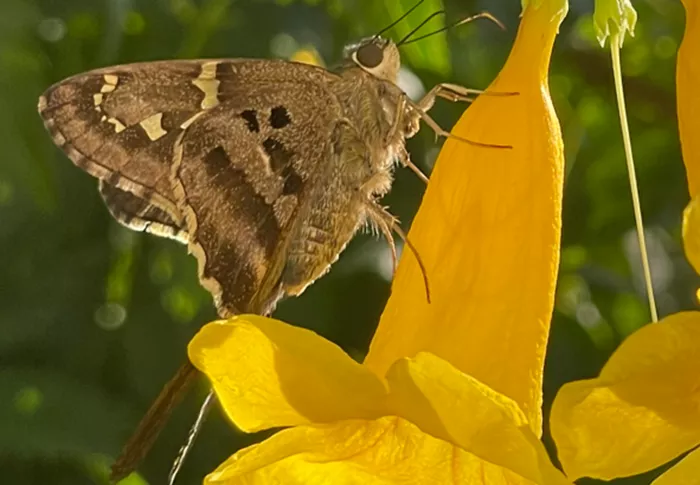As the sun began to set on the back deck of the South Padre Island Birding, Nature Center and Alligator Sanctuary, I observed a striking black and yellow hooded warbler drinking from the water feature in Songbird Alley. I was among a group of avid birdwatchers, many of whom had traveled great distances to photograph the fall migratory birds. However, my attention was often drawn to the bright yellow blossoms of the nearby Esperanza shrub. The area buzzed with activity, as countless nectar-seeking insects flitted in and out of the vibrant blooms.
Known scientifically as Tecoma stans, Esperanza is recognized in Texas for its bright yellow flowers and is commonly referred to as yellow bells or yellow trumpet flower. While not a native plant to the Lower Rio Grande Valley, it is close enough, originating from the Rio Grande River basin in southwest Texas, several hundred miles away in the Trans-Pecos region. Esperanza is also found in southern New Mexico, Arizona, and extends through Mexico to northwestern South America, as well as parts of southern Florida and the Caribbean.
The plant adapts to various climates and soil conditions, resulting in several subspecies. The variety seen in the American Southwest tends to be shorter and is more resilient to cold and drought compared to those in tropical regions. Many cultivated varieties and hybrids of Esperanza thrive in the Lower Rio Grande Valley, where the shrub blooms profusely from spring through winter. Its consistent beauty is likely why it was introduced to the area.
Esperanza’s striking blossoms not only attract the eyes of humans but also draw in a variety of pollinators, including bees, butterflies, and hummingbirds, who rely on its nectar. Even after the flowering season ends, the plant’s green, bean-shaped seed pods provide food for wintering songbirds and small mammals.
Historically, humans have utilized Esperanza for many purposes. According to a Texas A&M webpage from 2009, “Tecoma stans was long known and used by the Indian and Mexican peoples of the Southwest and Mexico for bowmaking, bee fodder, and medicines.” In Mexico, a beer was even made from its roots. The domesticated varieties of Esperanza have become popular for xeriscaping and pollinator gardens, as they flourish in full sun, endure high temperatures, and require minimal water.
The classification of Esperanza as a native plant in Texas, but not specifically in the Lower Rio Grande Valley, raises an intriguing question: “What defines a native plant?” This inquiry often leads to a follow-up question: “Why does it matter?”
Related topics:
- Diwali 2024: Inspiring Ideas to Transform Leftover Puja Flowers into Beautiful Creations
- Beyond Sales: How Pilsen Flower Shops Celebrate Community with Día De Los Muertos Marigolds
- Kikwetu Flowers: More Than Premium Roses—A Commitment to Sustainability and Social Welfare


